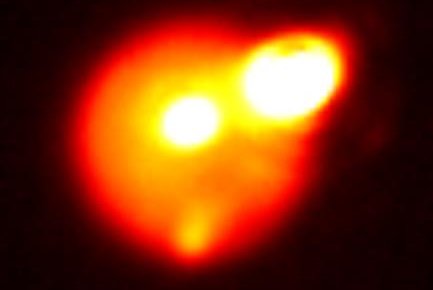One of three major volcanic outbursts on Jupiter's moon Io. (Katherine de Kleer/UC Berkeley/Gemini Observatory)
PASADENA, Calif., Aug. 5 (UPI) -- Jupiter's moon Io featured three massive volcanic eruptions within a two-week span last summer, leading astronomers to believe the "pizza moon" -- named so for its cratered, pepperoni-like surface -- may spew molten rock more often that scientists previously believed.
"We typically expect one huge outburst every one or two years, and they're usually not this bright," explained Imke de Pater, NASA scientist and professor and chair of astronomy at the University of California, Berkeley.
De Pater has been studying Jupiter and its moons for some time and recently penned one of two papers focusing on the moon's recent spate of violent eruptions.
"Here we had three extremely bright outbursts, which suggest that if we looked more frequently we might see many more of them on Io," de Pater said.
Io is roughly the same size as Earth's moon at 2,300 miles across, and it's the innermost of Jupiter's four large "Galilean" moons. The gravitational pull of Jupiter and its other moons creates a sort of tug-of-war that churns up Io's insides and enables the hot volcanic eruptions.
"These new events are in a relatively rare class of eruptions on Io because of their size and astonishingly high thermal emission," said Ashley Davies, a volcanologist with NASA's Jet Propulsion Laboratory in Pasadena, California.
Davies is credited as coauthor on de Pater's recent paper on Io -- one of two set to be published in the journal Icarus.
"The amount of energy being emitted by these eruptions implies lava fountains gushing out of fissures at a very large volume per second, forming lava flows that quickly spread over the surface of Io," Davies added.
De Pater and Davies were able to detect and study Io's eruptions using imagery from NASA's Keck II and Gemini North telescopes, as well as other skywatchers based at NASA's Infrared Telescope Facility.
The researchers say Io could offer clues as to how an early Earth behaved as well as how different parts of the solar system mature and evolve. Both Venus and Earth were shaped by extreme volcanism in their earliest years.
"I saw this as a nice opportunity to more closely connect one end of solar system formation/evolution to another," said David R. Ciardi, a colleague of de Pater and Davies and coauthor of another Io paper. "Understanding our solar system will help understand all the other systems we are finding and vice versa."















